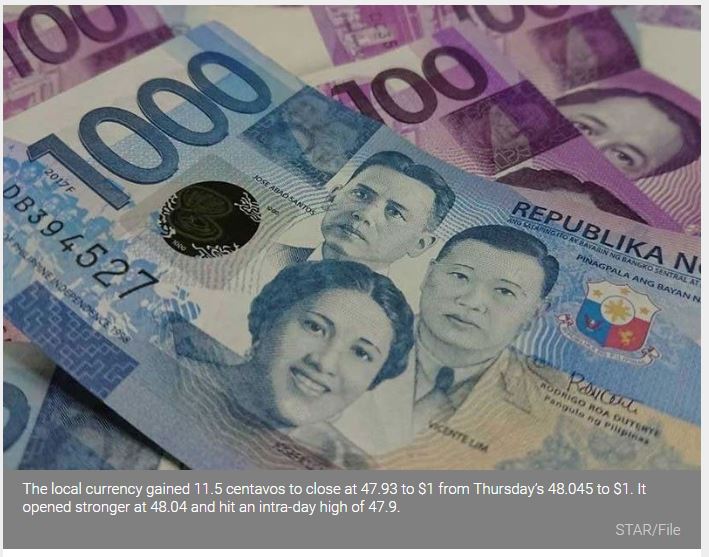Philippines: Peso strongest in 4 years as forex reserves ease
MANILA, Philippines — The peso yesterday pierced the 47 to $1 level to hit its strongest level in more than four years as the country’s foreign exchange buffer eased in January from an all-time high in December.
The local currency gained 11.5 centavos to close at 47.93 to $1 from Thursday’s 48.045 to $1. It opened stronger at 48.04 and hit an intra-day high of 47.9.
This was the strongest level for the peso since closing at 47.83 to $1 in Sept, 22, 2016.
Trading volume was heavy yesterday reaching $1.51 billion, more than double the $727.5 billion booked last Feb. 11. There was no trading last Friday due to the celebration of the Chinese New Year.
ING Bank senior economist Nicholas Mapa said the appreciation trend of the peso is seen continuing this year due to soft corporate demand, resulting to lower imports due to the impact of COVID-19 on the global economy and trade.
“As mentioned, soft corporate demand for the US dollar tied, manifested in weak imports will likely remain in 2021 given the ongoing economic slump, albeit at a less pronounced clip with some import demand returning,” Mapa said.
The peso emerged as one of the best performing currencies in the region gaining a little over five percent to close at 48.04 to $1 in 2020 from 50.635 to $1 in 2019.
“Financial account flows also carried the peso to a strong showing in 2020 and we expect financial account flows to continue to come in, but this too will be at a weaker pace compared to last year,” Mapa said.
The Bangko Sentral ng Pilipinas (BSP) reported that the country’s gross international reserves (GIR) slipped by 1.2 percent to $108.8 billion in January from an all-time high of $110.12 billion in December.
“The month-on-month decrease in the GIR level reflected outflows mainly from the foreign currency withdrawals of the national government from its deposits in the BSP to pay its foreign currency debt obligations and revaluation adjustments from the BSP’s gold holdings due to the decrease in the price of gold in the international market,” the central bank said.
The outflows, according to the central bank, were partly offset by the inflows from the BSP’s foreign exchange operations and income from its investments abroad.
The BSP said the latest GIR level is equivalent to around 11.6 months’ worth of imports of goods and payments of services and primary income. The buffer is also about 9.4 times the country’s short-term external debt based on original maturity and 5.1 times based on residual maturity.
Source: https://www.philstar.com/business/2021/02/16/2077962/peso-strongest-4-years-forex-reserves-ease


 English
English




